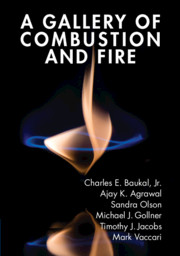Book contents
5 - Industrial Flames
Published online by Cambridge University Press: 17 June 2020
Summary
Industrial combustion processes are unique compared to the other chapter subjects in this book by virtue of their scale and diversity. For example, a large flame produced by a flare in a petrochemical plant could exceed 100 m in length, and individual burners in large power boilers could be over 100 MW firing capacity each. There are numerous types of combustors that have many names such as heaters, furnaces, ovens, kilns, dryers, boilers, thermal oxidizers, crackers, reformers, and smelters. The processes range in temperatures from as low as 300K for some food heating and drying processes to as high as over 2,000 K for some glass and metals production processes. Fuels can be solid (e.g., coal), liquid (e.g., oil), or gaseous (e.g., natural gas). Some processes are batch (e.g., rotary aluminum melting furnaces) or continuous (e.g., float glass furnaces). The combustors come in a wide range of shapes and sizes including both horizontal (e.g., cement kiln) and vertical cylinders (e.g., vertical cylindrical process heaters), approximately spheres (e.g., electrical arc furnaces with supplement burners), and rectangular boxes (e.g., cabin heaters used in the petrochemical industry). Some include heat recuperation that may be recuperative (e.g., air preheaters used on process heaters) or regenerative (e.g., air preheaters used in glass melting furnaces). Some processes use oxygen-enhanced combustion ranging from low-level enrichment (e.g., to enhance scrap aluminum melting) up to complete replacement of the combustion air with pure oxygen (e.g., supplemental burners used to enhance electric arc furnaces).
- Type
- Chapter
- Information
- A Gallery of Combustion and Fire , pp. 107 - 139Publisher: Cambridge University PressPrint publication year: 2020



